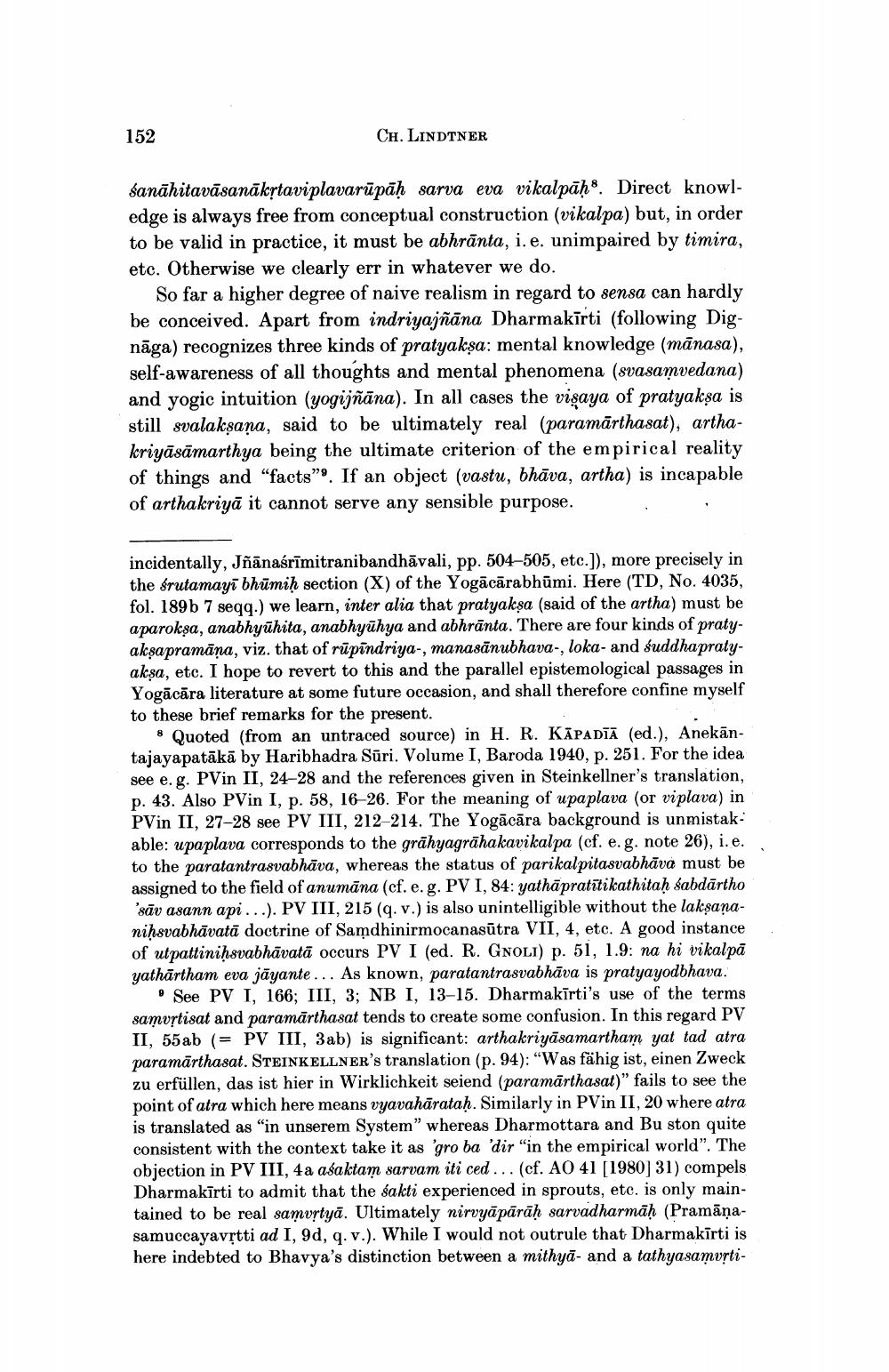Book Title: Marginalia To Dharmakirtis Pramanaviniscaya I II Author(s): Christian Lindtner Publisher: Christian Lindtner View full book textPage 4
________________ 152 CH. LINDTNER sanahitavāsanākṛtaviplavarupāḥ sarva eva vikalpāḥ8. Direct knowledge is always free from conceptual construction (vikalpa) but, in order to be valid in practice, it must be abhrānta, i.e. unimpaired by timira, etc. Otherwise we clearly err in whatever we do. So far a higher degree of naive realism in regard to sensa can hardly be conceived. Apart from indriyajñāna Dharmakīrti (following Dignāga) recognizes three kinds of pratyaksa: mental knowledge (mānasa), self-awareness of all thoughts and mental phenomena (svasamvedana) and yogic intuition (yogijñāna). In all cases the visaya of pratyaksa is still svalakṣaṇa, said to be ultimately real (paramarthasat), arthakriyāsāmarthya being the ultimate criterion of the empirical reality of things and "facts". If an object (vastu, bhava, artha) is incapable of arthakriya it cannot serve any sensible purpose. incidentally, Jñanaśrīmitranibandhavali, pp. 504-505, etc.]), more precisely in the śrutamayi bhumiḥ section (X) of the Yogacarabhūmi. Here (TD, No. 4035, fol. 189b 7 seqq.) we learn, inter alia that pratyakṣa (said of the artha) must be aparoksa, anabhyuhita, anabhyuhya and abhrānta. There are four kinds of pratyakṣapramāna, viz. that of rupindriya-, manasanubhava-, loka- and suddhapratyaksa, etc. I hope to revert to this and the parallel epistemological passages in Yogacara literature at some future occasion, and shall therefore confine myself to these brief remarks for the present. 8 Quoted (from an untraced source) in H. R. KAPADIA (ed.), Anekāntajayapatākā by Haribhadra Sūri. Volume I, Baroda 1940, p. 251. For the idea see e. g. PVin II, 24-28 and the references given in Steinkellner's translation, p. 43. Also PVin I, p. 58, 16-26. For the meaning of upaplava (or viplava) in PVin II, 27-28 see PV III, 212-214. The Yogacara background is unmistakable: upaplava corresponds to the grahyagrahakavikalpa (cf. e. g. note 26), i. e. to the paratantrasvabhava, whereas the status of parikalpitasvabhāva must be assigned to the field of anumana (cf. e. g. PV I, 84: yathapratitikathitaḥ sabdartho sav asann api...). PV III, 215 (q. v.) is also unintelligible without the lakṣaṇaniḥsvabhāvatā doctrine of Samdhinirmocanasūtra VII, 4, etc. A good instance of utpattiniḥsvabhāvatā occurs PV I (ed. R. GNOLI) p. 51, 1.9: na hi vikalpā yathārtham eva jayante... As known, paratantrasvabhava is pratyayodbhava. See PV I, 166; III, 3; NB I, 13-15. Dharmakirti's use of the terms samvṛtisat and paramarthasat tends to create some confusion. In this regard PV II, 55ab (= PV III, 3ab) is significant: arthakriyasamartham yat tad atra paramarthasat. STEINKELLNER's translation (p. 94): "Was fähig ist, einen Zweck zu erfüllen, das ist hier in Wirklichkeit seiend (paramarthasat)" fails to see the point of atra which here means vyavaharataḥ. Similarly in PVin II, 20 where atra is translated as "in unserem System" whereas Dharmottara and Bu ston quite consistent with the context take it as 'gro ba 'dir "in the empirical world". The objection in PV III, 4a aśaktam sarvam iti ced... (cf. AO 41 [1980] 31) compels Dharmakirti to admit that the śakti experienced in sprouts, etc. is only maintained to be real samvṛtyä. Ultimately nirvyāpārāḥ sarvadharmaḥ (Pramāṇasamuccayavṛtti ad I, 9d, q. v.). While I would not outrule that Dharmakirti is here indebted to Bhavya's distinction between a mithya- and a tathyasamvṛtiPage Navigation
1 2 3 4 5 6 7 8 9 10 11 12 13 14 15 16 17 18 19 20 21 22 23 24 25 26 27
